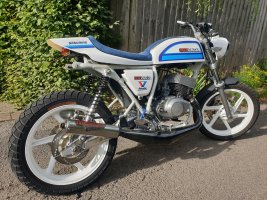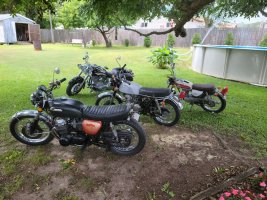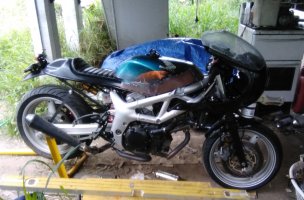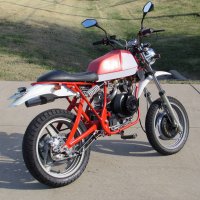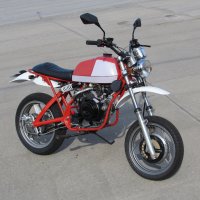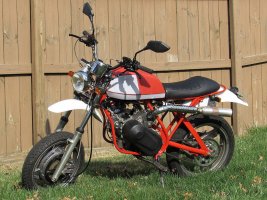We noticed you are blocking ads. DO THE TON only works with community supporters. Most are active members of the site with small businesses. Please consider disabling your ad blocking tool and checking out the businesses that help keep our site up and free.
You are using an out of date browser. It may not display this or other websites correctly.
You should upgrade or use an alternative browser.
You should upgrade or use an alternative browser.
Post a pic of your motorcycle as it sits
- Thread starter RobbyD
- Start date
DesmoDog
Been Around the Block
Thanks, I've got more work to do but it's getting there. It's a 900ss but not a Super Light. Super Lights (in the USA) had different (two piece) wheels.I saw white frame and thought 851 but it looks more like an SS Superlight.
Looks good.
I sold my 851 to get that Super Light. The 851 is one of my favorites but so is the Super Light so when one came and found me I had to make a choice.
'91 (and '92?) Super Sports also had white frames. And white wheels. But this isn't one of those either.
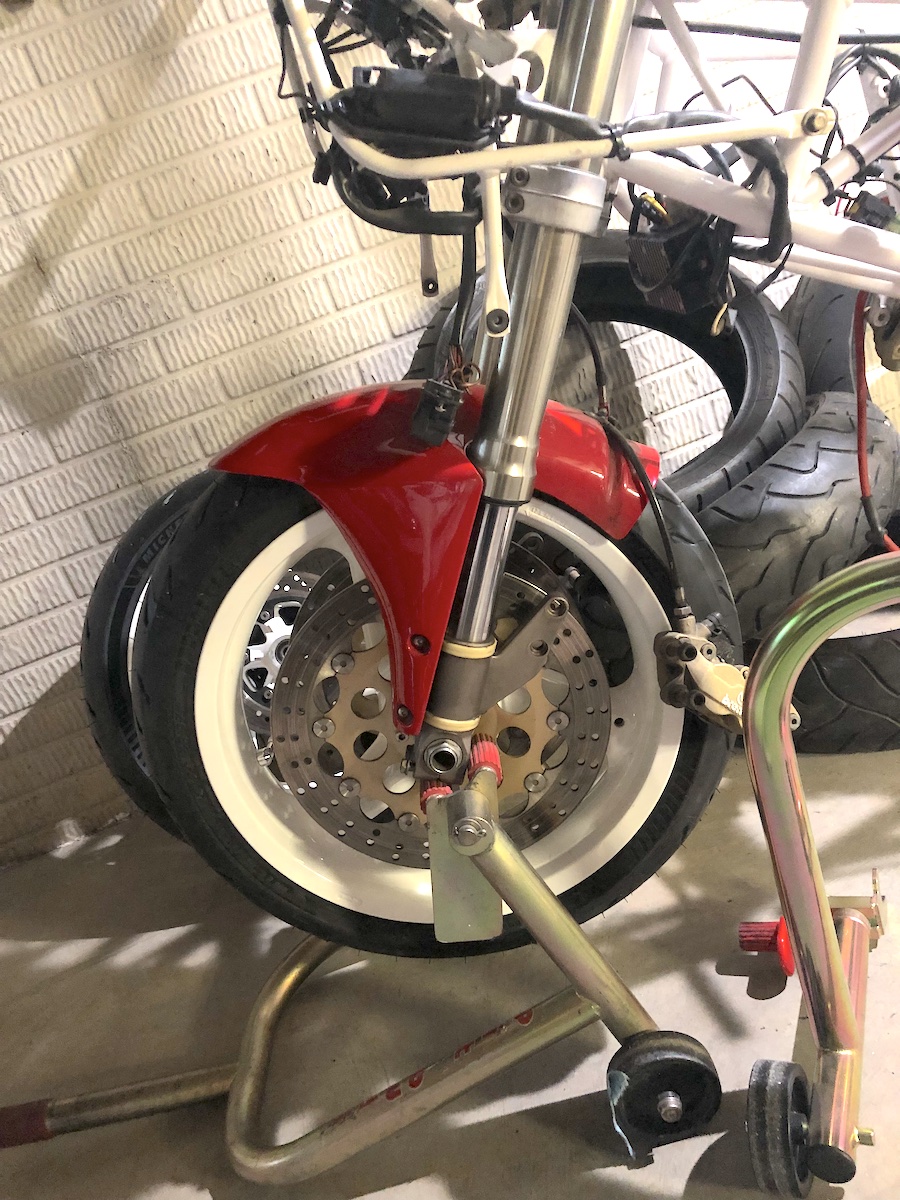
Tanshanomi
Active Member
My snowblower-powered CVT roadster. I had a bunch of extra parts on the workshop shelves, so I decided to put them together. The engine is a 6-1/2 HP Honda GX200 clone. It is nowhere near finished, but as of this morning, it's at least rideable.


- 1974 Panther Black Shadow DB175 frame
- LCT 208cc engine, as used in Husqvarna snowblowers with CVT torque converter
- 1976 Yamaha YZ125C swingarm
- 1989 Honda VTR250 Interceptor inboard disc front wheel
- 1982 Suzuki GS650GL front forks
- 1985 Yamaha XJ700 Maxim front fender
- 1977 Can-Am Qualifier fuel tank
- 1995 Kawasaki EX500 rear wheel
- Suzuki 500 Vinson ATV rear caliper
- Honda CRF150 rear sprocket
- Honda ATC90 foot pegs
Last edited:
DesmoDog
Been Around the Block
Back to making progess on the 900ss track bike. In fact I should be working on it now instead of surfing the 'net...
Engine is back together, ugly swingarm was refinished with a $7 spray bomb. Tail and hugger are just sitting there to get them off the bench but it's getting there. Just in time for the season to be over.

Engine is back together, ugly swingarm was refinished with a $7 spray bomb. Tail and hugger are just sitting there to get them off the bench but it's getting there. Just in time for the season to be over.
Tanshanomi
Active Member
I am happy to report that having now put some miles on The Bride of Frankenstein, it’s a win in my book.My snowblower-powered CVT roadster. I had a bunch of extra parts on the workshop shelves, so I decided to put them together. The engine is a 6-1/2 HP Honda GX200 clone. It is nowhere near finished, but as of this morning, it's at least rideable.
- 1974 Panther Black Shadow DB175 frame
- LCT 208cc engine, as used in Husqvarna snowblowers with CVT torque converter
- 1976 Yamaha YZ125C swingarm
- 1989 Honda VTR250 Interceptor inboard disc front wheel
- 1982 Suzuki GS650GL front forks
- 1985 Yamaha XJ700 Maxim front fender
- 1977 Can-Am Qualifier fuel tank
- 1995 Kawasaki EX500 rear wheel
- Suzuki 500 Vinson ATV rear caliper
- Honda CRF150 rear sprocket
- Honda ATC90 foot pegs
The overall riding experience is peculiar, but easy and fun. Think of it as a Honda Navi with bigger wheels and better brakes.
I paid a lot of attention to the steering geometry early on, and despite the odd look of the trailing-axle fork, it works. The steering is easy and predictable—neither truckish nor squirrelly. The suspension is better than those bargain-basement damper units would suggest. The engine starts from cold with just a moment of choke, idles nicely, and pulls through the rev range without hesitation. It took a few miles to remember that the rear brake is on the left handlebar instead of under my right foot.
There are few niggles. The $35 seat feels exactly as comfortable as you’d expect from a $35 seat. The super-wide, non-folding ATC footpegs aren’t optimal. Their width not only complicates getting the bike in and out of the garage, but they also vibrate a bit on the road. Surprisingly, I didn’t feel much vibration through rest of the bike and the mirrors stayed clear.
The engine got an aftermarket crankshaft, ARC billet rod, and Tillitson flat-top piston. It has full electrical system, with 60-watt alternator, an electric starter, and full street lighting.
My design goal for this bike was 50+ MPH, and it is just able to meet that top speed. However, acceleration requires an eye on the tach. Whack open the throttle with abandon and the ungoverned engine can exceed 4000 RPM before the CVT’s gearing can catch up. The tach’s “max” memory function currently reads 4310 RPM—not alarming, but definitely approaching iffy territory for a cast flywheel. A little bit slower roll-on is all it takes to keep things in a safer range.
Given the motley collection of components I started with, I’m thoroughly tickled with the result. I love the uniqueness of it. Even I would have never conceived of this machine, if not for the collection of parts I had to work with. I knew it would be a novel curiosity and a rewarding project. But it’s actually a genuinely usable, thoroughly street-worthy means of transportation, which I wasn’t too sure I could pull off.
So, with that, I am calling this project complete. The bike works as well and looks as good as it probably ever will. So here a couple official glamour shots.
Attachments
Maritime
Over 10,000 Posts
awesomeI am happy to report that having now put some miles on The Bride of Frankenstein, it’s a win in my book.
The overall riding experience is peculiar, but easy and fun. Think of it as a Honda Navi with bigger wheels and better brakes.
I paid a lot of attention to the steering geometry early on, and despite the odd look of the trailing-axle fork, it works. The steering is easy and predictable—neither truckish nor squirrelly. The suspension is better than those bargain-basement damper units would suggest. The engine starts from cold with just a moment of choke, idles nicely, and pulls through the rev range without hesitation. It took a few miles to remember that the rear brake is on the left handlebar instead of under my right foot.
There are few niggles. The $35 seat feels exactly as comfortable as you’d expect from a $35 seat. The super-wide, non-folding ATC footpegs aren’t optimal. Their width not only complicates getting the bike in and out of the garage, but they also vibrate a bit on the road. Surprisingly, I didn’t feel much vibration through rest of the bike and the mirrors stayed clear.
The engine got an aftermarket crankshaft, ARC billet rod, and Tillitson flat-top piston. It has full electrical system, with 60-watt alternator, an electric starter, and full street lighting.
My design goal for this bike was 50+ MPH, and it is just able to meet that top speed. However, acceleration requires an eye on the tach. Whack open the throttle with abandon and the ungoverned engine can exceed 4000 RPM before the CVT’s gearing can catch up. The tach’s “max” memory function currently reads 4310 RPM—not alarming, but definitely approaching iffy territory for a cast flywheel. A little bit slower roll-on is all it takes to keep things in a safer range.
Given the motley collection of components I started with, I’m thoroughly tickled with the result. I love the uniqueness of it. Even I would have never conceived of this machine, if not for the collection of parts I had to work with. I knew it would be a novel curiosity and a rewarding project. But it’s actually a genuinely usable, thoroughly street-worthy means of transportation, which I wasn’t too sure I could pull off.
So, with that, I am calling this project complete. The bike works as well and looks as good as it probably ever will. So here a couple official glamour shots.
Luugo86
'73 CB350, '78 XS650 Cafe Killer
That is a cool little mini-bike man!
I am happy to report that having now put some miles on The Bride of Frankenstein, it’s a win in my book.
The overall riding experience is peculiar, but easy and fun. Think of it as a Honda Navi with bigger wheels and better brakes.
I paid a lot of attention to the steering geometry early on, and despite the odd look of the trailing-axle fork, it works. The steering is easy and predictable—neither truckish nor squirrelly. The suspension is better than those bargain-basement damper units would suggest. The engine starts from cold with just a moment of choke, idles nicely, and pulls through the rev range without hesitation. It took a few miles to remember that the rear brake is on the left handlebar instead of under my right foot.
There are few niggles. The $35 seat feels exactly as comfortable as you’d expect from a $35 seat. The super-wide, non-folding ATC footpegs aren’t optimal. Their width not only complicates getting the bike in and out of the garage, but they also vibrate a bit on the road. Surprisingly, I didn’t feel much vibration through rest of the bike and the mirrors stayed clear.
The engine got an aftermarket crankshaft, ARC billet rod, and Tillitson flat-top piston. It has full electrical system, with 60-watt alternator, an electric starter, and full street lighting.
My design goal for this bike was 50+ MPH, and it is just able to meet that top speed. However, acceleration requires an eye on the tach. Whack open the throttle with abandon and the ungoverned engine can exceed 4000 RPM before the CVT’s gearing can catch up. The tach’s “max” memory function currently reads 4310 RPM—not alarming, but definitely approaching iffy territory for a cast flywheel. A little bit slower roll-on is all it takes to keep things in a safer range.
Given the motley collection of components I started with, I’m thoroughly tickled with the result. I love the uniqueness of it. Even I would have never conceived of this machine, if not for the collection of parts I had to work with. I knew it would be a novel curiosity and a rewarding project. But it’s actually a genuinely usable, thoroughly street-worthy means of transportation, which I wasn’t too sure I could pull off.
So, with that, I am calling this project complete. The bike works as well and looks as good as it probably ever will. So here a couple official glamour shots.
Nooooooooo
Maritime
Over 10,000 Posts
Snowing today and after riding in the snow on my last ride it's time. Worst part of the year.Nooooooooo
Thanks guys. never have I needed to use so much degreaser on a bike. Everything was covered in baked on oil or was rusty and most things were bent or twisted from excess gravity... She came up OK though. many replacement parts appear to be made in India and they do a great job but things don't always fit and require a lot of work to get them right.


